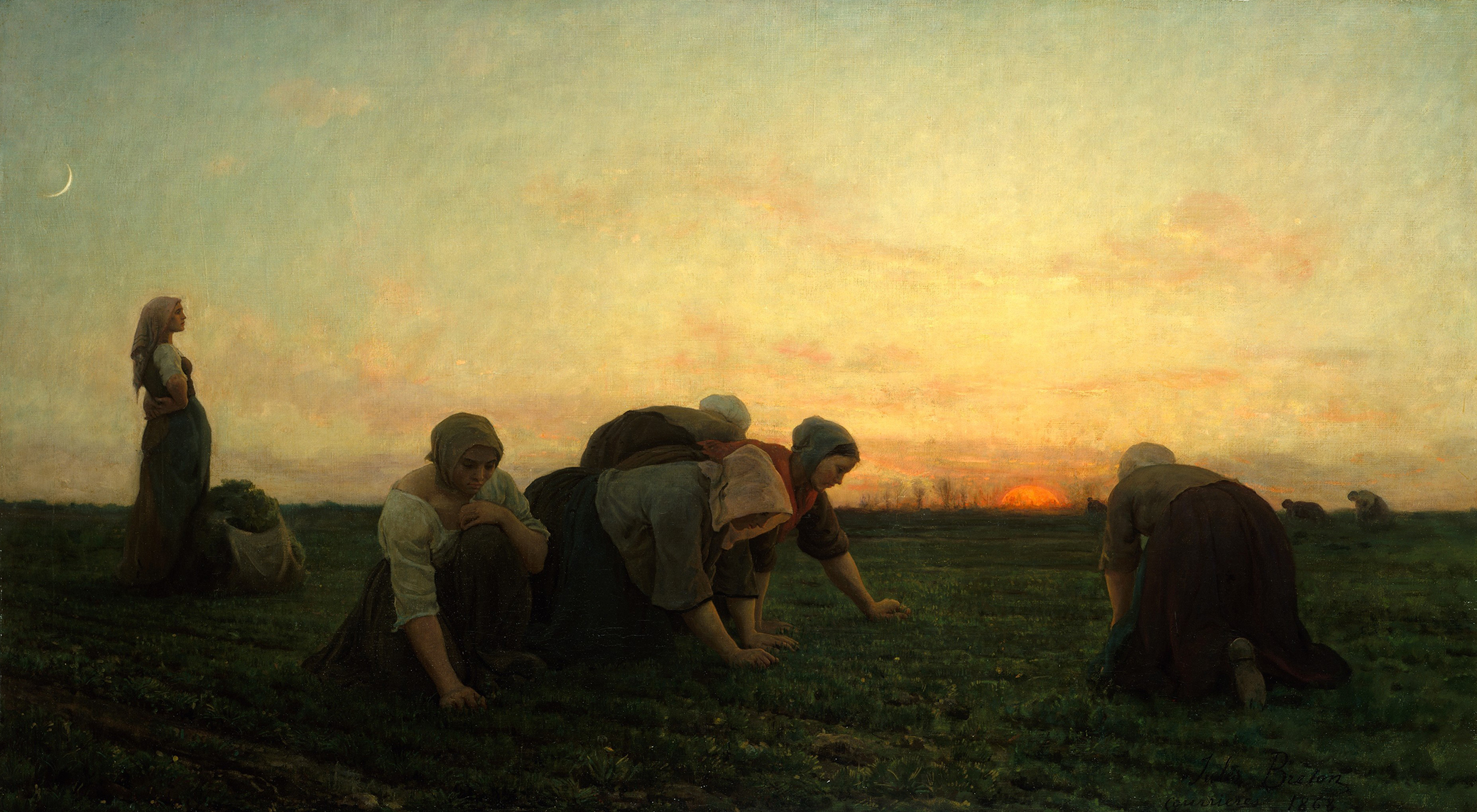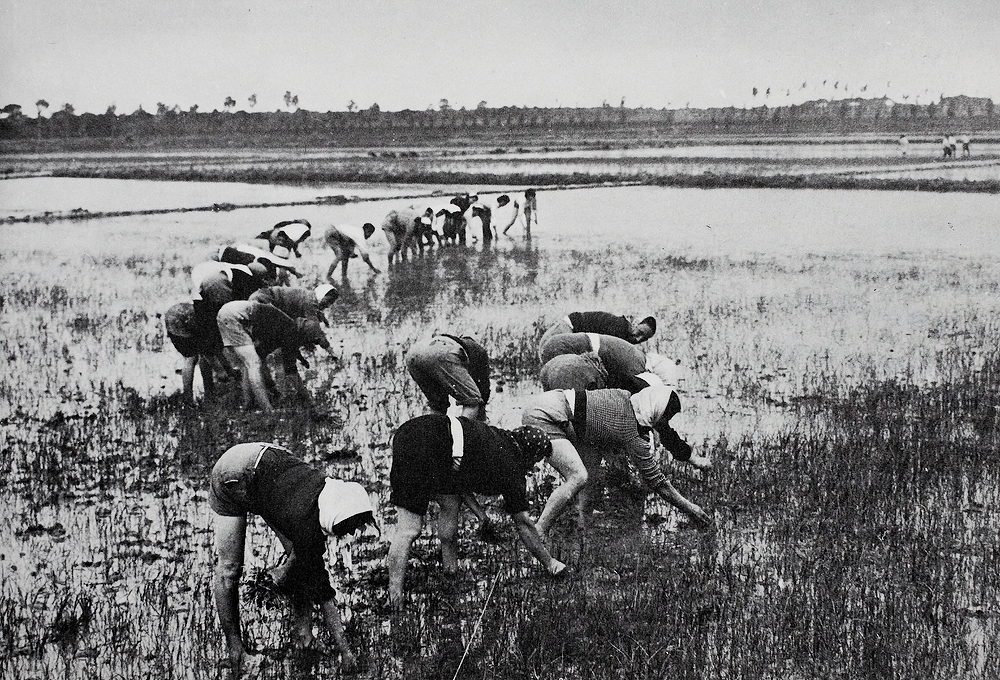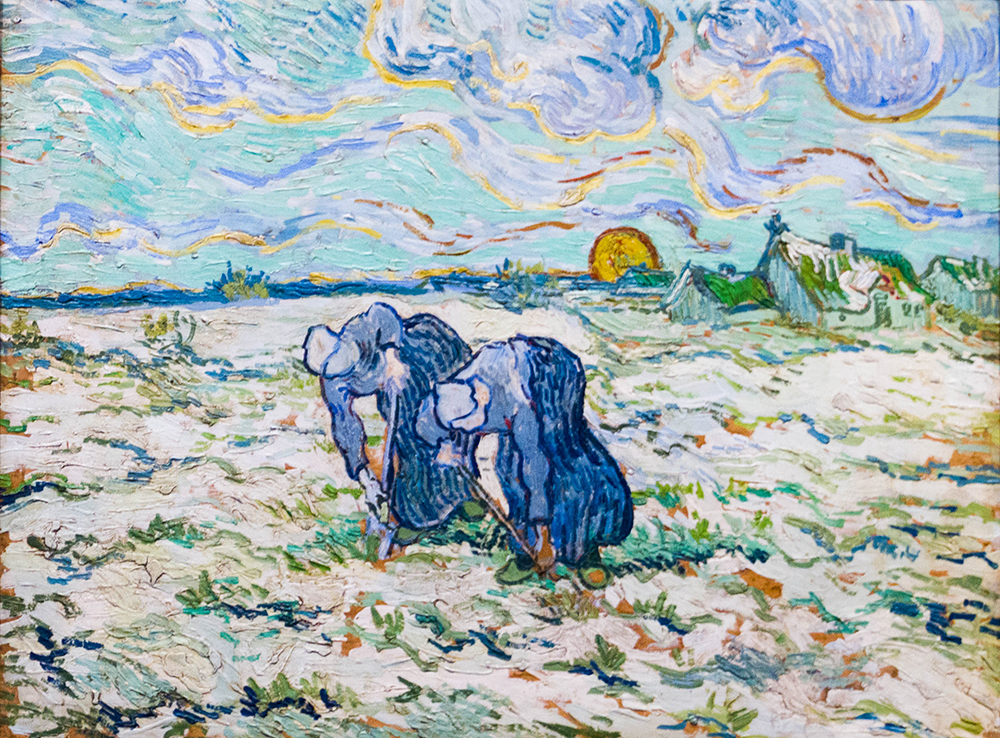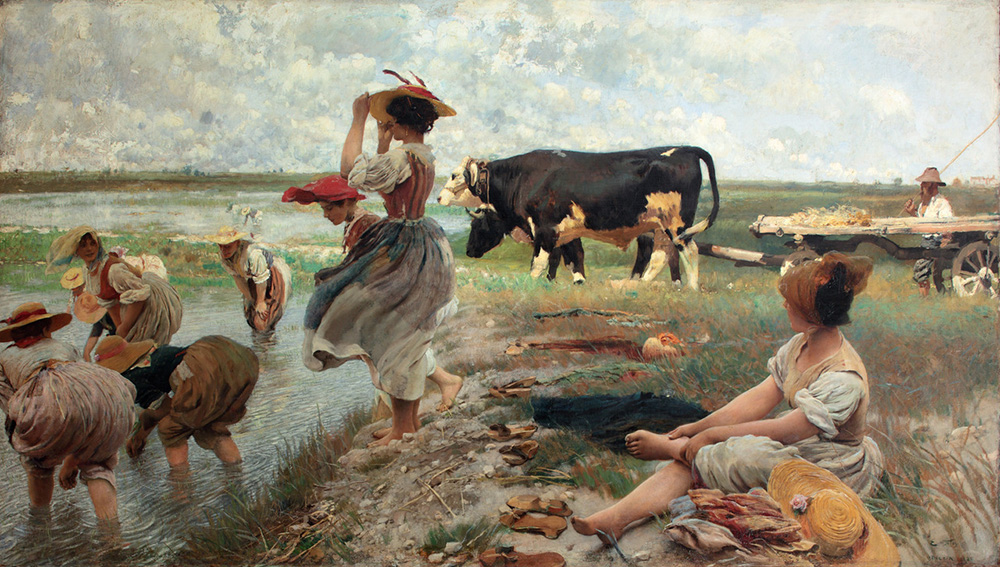
The Weeders, by Jules Breton, 1868. The Metropolitan Museum of Art, Bequest of Collis P. Huntington, 1900.
In the early spring, when the rice crops of the Po Valley—a fertile region of northern Italy fed by the country’s longest river—were about two months old, thousands of women would leave behind their homes and families and travel by train, truck, or foot to labor in the flooded rice paddies. From around the seventeenth century until the 1960s, these women would arrive in towns such as Vercelli, Novara, and Cremona to work forty days each year as mondine, rice weeders. From dawn until dusk they stood in knee-deep water, plucking the weeds from the fledgling crops and stopping only to snack on meager rations. The crops had to be weeded multiple times throughout the growing process to prevent the young rice from being choked by other vegetation before it could be harvested. The flooded fields attracted malaria-carrying mosquitoes that stalked the women while they worked and as they retired to their threadbare dormitories. Conditions were so bad that in the early 1950s an Italian senator remarked, “Dante did not know the work of the rice weeders; if he did, he would have described it as a punishment in some circle of farmer hell.”
The mondine were not merely meek mothers, victims to an arduous job, however. The rice paddy was a red zone, a breeding ground of socialist, communist, and peasant-centered political ideology. At its center was a chorus of women, heads bowed and backs curved, harmonizing while they worked.
Through songs of resistance and revolution, the fields fostered radicalism. The older weeders would use the lyrics to teach the younger workers the history of protest, agitation, and activism, including that of the mondine themselves. “Bella Ciao” is perhaps their most famous song from the fields, though they are rarely acknowledged as its source. The lyrics describe a typical workday for the mondine as they leave their families to toil in the fields under the violent gaze of the foreman with his rod.
Alla mattina, appena alzata
(coro) O bella ciao, bella ciao, bella ciao, ciao, ciao
alla mattina appena alzata in risaia mi tocca andar.
E tra gli insetti e le zanzare
(coro) O bella ciao, bella ciao, bella ciao, ciao, ciao
un duro lavoro mi tocca a far.
In the morning just got up
(chorus) Oh bye beautiful, bye beautiful, bye beautiful, bye, bye,
In the morning just awakened
in the rice fields I must go.
And among the insects and the mosquitoes
(chorus) Oh bye beautiful, bye beautiful, bye beautiful, bye, bye,
A difficult work I must do.
In the decades since the mondine labored, “Bella Ciao” has been used in the Netflix show Money Heist and remixed, EDM-style, by DJ Steve Aoki. It has permeated Kurdish culture as a song of resistance. In Italy the song has been used more recently to protest the xenophobic policies of the far-right political party Lega Nord (Northern League) and its member Matteo Salvini, who served as deputy prime minister. Amid the COVID-19 pandemic “Bella Ciao” has had its latest resurgence. Videos have circulated showing Italians in Rome, Germans from the Bavarian town of Bamberg, and firefighters in the UK singing “Bella Ciao” from their balconies and rooftops and via YouTube. The Serbian National Theatre even recorded an orchestral version of “Bella Ciao” with each musician performing their part in isolation. The version sung today, however, is not that of the mondine. During World War II, “Bella Ciao” was adopted by the Italian partisans as an anti-fascist song. The two songs share the same melody and refrain, but the lyrics have been altered to reflect their different oppressors: for the rice weeders it was the padroni, the foremen; for the partisans it was the Fascists. The origins of “Bella Ciao” are uncertain, but one version has been continuously remembered, adapted, and performed while the other has largely been written out of popular history, much like the legacy of the rice weeders themselves.
The Italian novelist Italo Calvino wrote, “Battles over the dignity of the Italian people have been fought in the rice fields.” In 1906 the town of Vercelli—located in the region of Piedmont, between Turin and Milan—was a site of one such battle. At the time, Italy had recently emerged from a period of repressive rule under King Umberto I, who was known to quash protests with violence, martial law, and restrictions on civil liberties. In 1900 he was assassinated by the Italian anarchist Gaetano Bresci, and Victor Emmanuel III became king. The new government favored constitutional rule, and trade unions across the country flourished. At the end of 1906 Italy’s radical Socialist Party, to which many of the mondine had at least a loose affiliation, formed Italy’s largest trade union, the General Italian Confederation of Labour (CGIL), which remains active today.

In May 1906, during the first days of the weeding season, the mondine began work stoppages with the ultimate goal of implementing an eight-hour workday. For decades, the rice weeders had worked in excess of ten hours per day. Because they were paid per day and overtime did not exist, their hourly wage kept decreasing. Forty years before, as malaria ran rampant through the fields, the Cantelli regulations of 1866—which prohibited work at dawn or after dusk, restricting possible work hours—was implemented to protect the weeding population. While the law was poorly enforced, it was something the mondine could build upon. As the historian Elda Gentili Zappi wrote in her book on the mondine, “the strikers marched from farm to farm carrying red and white banners, extolling the general strike, and singing the workers’ anthem as well as a new song that was suddenly on the lips of all the weeders.” That song would later be known as “If Eight Hours Seem Too Few,” and it describes the class struggle for an equitable working day.
Se otto ore sembran poche
provate voi a lavorar
e provarete la differenza
di lavorare e di comandar
If eight hours seem few to you
Try working
And you’ll see the difference
Between work and giving orders
While the strikes spread across the region, they were most explosive in Vercelli. In that city, alongside the mondine, metal workers, bakers, millers, gardeners, and women working in textile factories began demanding better hours and better pay. One day in late May the rice weeders intercepted people on their way to work, and they joined the strike; almost all of Vercelli shut down. In the following days, workers from all industries took over Piazza Torino, clashing with the troops sent in to disperse their protest and erecting barricades to prevent strikebreakers and the cavalry from entering the city. Eventually, the business owners conceded, prepared to resolve labor disputes if it meant that production resumed.
As a result of the mondine’s organizing, bakers won the abolition of night work; metal workers, gardeners, and others won a shorter workday and better pay; and the rice weeders, as their song demanded, won the eight-hour workday by pushing the national government to draft a new bill on rice cultivation that passed in 1907. But drastic labor changes are never easily implemented or retained, and the struggle did not end there for the mondine. Farmers, unhappy with the new legislation, sought out local lawmakers to help convince Prime Minister Giovanni Giolitti to repeal it. Giolitti decided to revoke the Cantelli regulations altogether, conceding to a growing conservative political climate. For the mondine, it took thousands more strikes and many more years to gain shorter work hours and higher pay. Their earliest foray into activism nonetheless set the tone for their future attempts to challenge the men in power and to struggle for a better working life through songs and strikes.
Given that the mondine were an all-female workforce, musical chorus, and activist group, it would be natural to suggest their political involvement was born of feminist ideas. But it is an anachronism to say they considered themselves feminists. The mondine saw their struggle as part of the international workers’ rights movement they knew of through union involvement, socialist newspapers, and the songs sung in the fields and passed down generation to generation. It was only later, through oral histories and interviews that asked them to reflect upon their lives, that many rice weeders situated their politics within the broader feminist movement. Yet to be a woman in the rice fields was to experience work through a set of inherently gendered problems.

Malaria, miscarriage, and menstruation were as intertwined for the rice weeders as their bodies were to the act of labor. Among the mondine—who, contrary to the regulations, worked through dusk and dawn in the malarial rice swamps—it was estimated that for every thousand children born, six hundred died in their first year of life. Complications such as premature birth and miscarriage were common, but the latter was not always unwelcome. Another baby meant another mouth to feed for an already impoverished family as well a momentary decline in income; pregnant women were forbidden by law from working in the rice fields. Writing about her mother’s work as a mondina from the 1920s onward, writer Laura Scalabrini describes how the women would go to the fields at night to miscarry under the darkened sky. The fetuses would “fall on the naked earth, where they were hidden among dirt clumps with a piteous turn of the hoe and, often, with a profound sigh of relief for that suddenly interrupted pregnancy.”
It was common for middle- and upper-class women to stop working during menstruation even well into the 1940s. This was rarely an option for the low-income rice weeders, whose periods often ceased during the weeding season because their work was so physically taxing. For many, this pause in their cycle was a welcome relief; for those with unwanted pregnancies, there were other ways to move the process along. Diana Garvin, an assistant professor of Italian at the University of Oregon who has studied the mondine, writes that the rice weeders would jump off chairs, drink tisanes of parsley, and of course do their regular work in the fields to try to induce miscarriages. One rice weeder, pregnant with her fifth child, “hoped with all her might for a miscarriage” as she followed these folk traditions. While she ended up carrying the fetus to term, the baby died within a few days of birth. There was a practicality to the rice weeders that did not necessarily hide their anguish or diminish their pain, but rather took into account what was realistic for a woman whose livelihood was wedded to her body.
From 1922 until World War II, during the height of Italian Fascism, Italy undertook an economic policy called the Battle for Grain. The aim of the propaganda campaign—which often portrayed Prime Minister Benito Mussolini bare-chested in Italy’s grain fields—was to increase Italy’s self-sufficiency by reducing the country’s reliance on imported grain from Turkey. At the time, Italy’s domestic grain production could not meet the nation’s need for bread and pasta, so women, often the family’s sole cook, were encouraged to increase their family’s consumption of local staples such as rice instead. In the same period, Italy’s birth rate was falling. The regime hoped to bolster the number of babies born in the Fascist state through government actions, including pamphlets on hygienic breastfeeding and tax incentives for families with children.
At the centers of both these policies were the women of the countryside, including the mondine. While the government dictated that a woman’s place was at home, the very nature of Italy’s plan for self-sufficiency required them to work in the fields. By 1922 only 5 to 20 percent of rice weeders were men, and women were paid around half as much for the same work. Propaganda portrayed these women as rustic and robust, maternal and working-class, celebrating them as “symbols of ideal Italian femininity,” writes Garvin. Yet even if the state wanted the bodies of rice weeders to be both bearers of children and laborers for the Fascists’ purported greater good, the women themselves had other ideas.
From the 1920s onward it was no secret that the majority of rice weeders voted for the Communist Party of Italy and carried in their wallets red voting cards symbolizing their resistance against the rising tide of Fascism. While Mussolini exalted the women as emblems of state-sanctioned motherhood, the rice weeders continued to use music in the fields as a rehearsal for rebellion. Throughout the Fascist period, even while other leftist groups were driven underground, the mondine staged strikes and protests, agitating for better hours, better pay, and better work conditions. They made considerable gains, too, such as improved food and shelter while they worked in the fields. The women’s politics went beyond the personal. During Nazi occupation, writes Flora Derounian, a lecturer at the University of Sussex, many rice weeders left the fields and “refused to work for their oppressors,” while others hid partisans in their homes and acted as couriers between battalions.

During protests and strikes, especially in the Fascist era, the mondine were often arrested and targets of police violence. In the 2008 Italian documentary Di Madre in Figlia (From Mother to Daughter), a former rice weeder recalls that she was so badly beaten by the police after a strike that she thought she would miscarry her unborn child. In 1949 Maria Margotti, a young widowed mother and staunch partisan, became one of the most famous martyrs of the Italian Resistance when she was killed by police during an agricultural protest in the town of Molinella. While Margotti died wearing a white scarf often associated with the rice weeders, it is unclear whether she worked full-time in the rice fields. But her very public and very visible death at the hands of the government was representative of the assaults workers experienced each year in the “less visible space of the rice paddies,” writes Laura E. Ruberto, a humanities professor at Berkeley City College. In the days and decades since her murder, Margotti became not only a heroine of the mondine but was more broadly mythologized by the left as a symbol of Fascist resistance, peasant revolt, and, as a plaque erected in her memory in Molinella reads, a “companion of all the oppressed.”
In the postwar years, when Italian neorealist cinema was at its height, Margotti, some have suggested, lived a visual afterlife through Silvana Mangano’s character in the 1949 film Bitter Rice, directed by Giuseppe De Santis. The film, which was nominated for an Academy Award and competed at the Cannes Film Festival, thrust a glamorized version of the rice weeders onto an international stage. But this global fame was fleeting; soon after, the mondine, like so many women of history, returned to obscurity.
In the rice weeders’ version of “Bella Ciao,” the choir moves from speaking in the singular “I” to using the plural “us.” It comes at the end of the song, when the women sing of a day when they “will work in liberty.” This shift mirrors the way the mondine experienced a world where their burdens came not only from manual labor but from the triumph of capital over welfare, and their victories were won not only for the individual but for the greater collective. For the mondine—separated from their families, plagued by disease, and performing the kind of labor we would currently deem “essential”—hardship was not some great equalizer across gender and class but was instead a call to song, a cause of dissent, and a reason to reimagine what the world of workers, of peasants, and of women could look like.